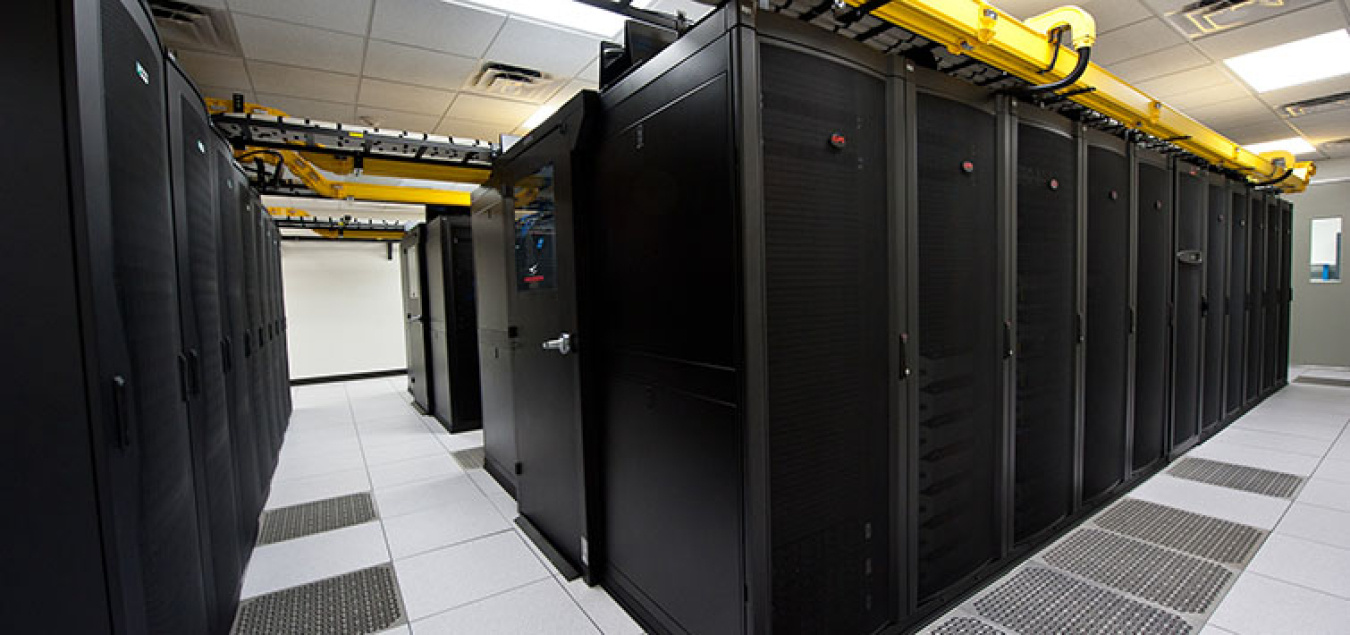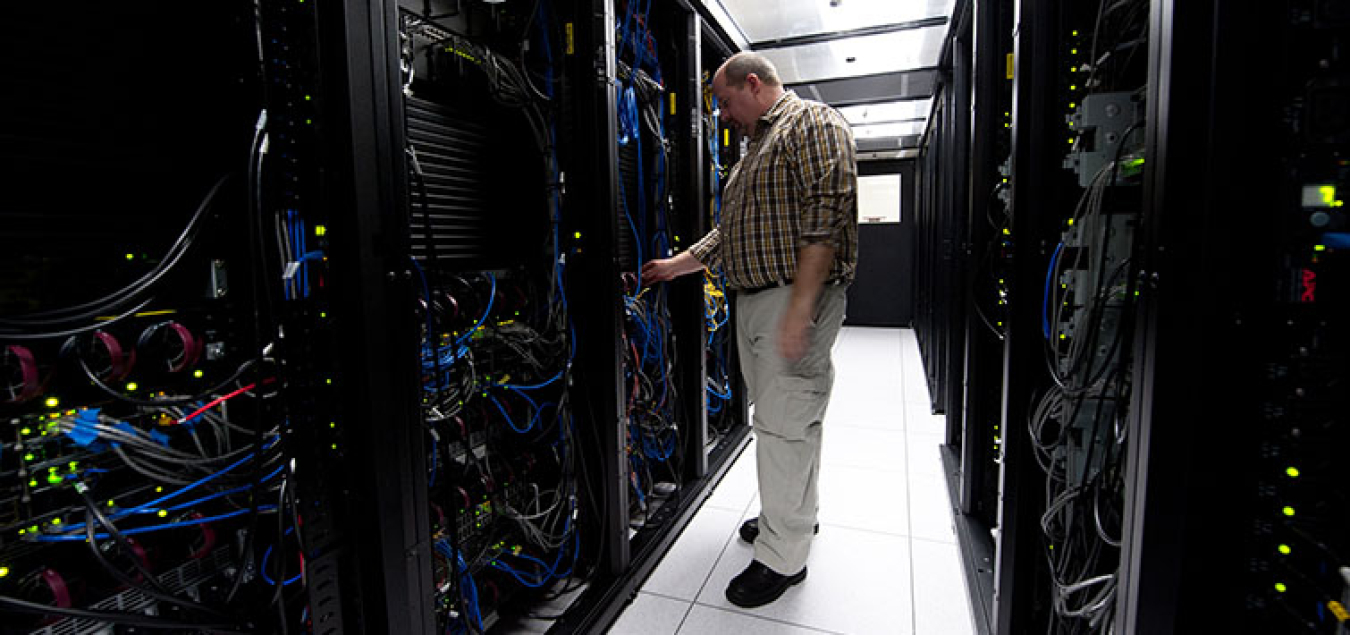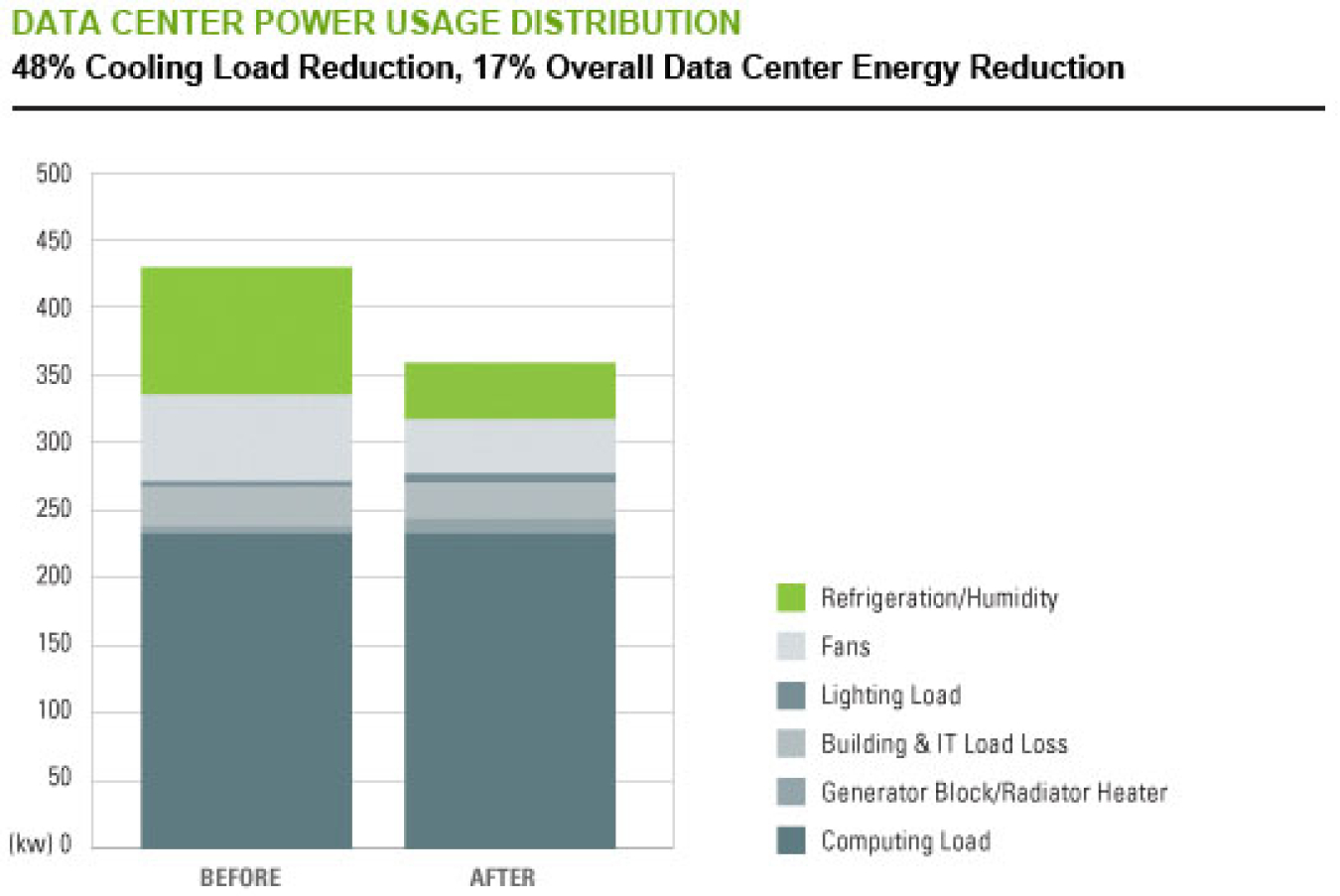
Server rack configuration in the data center at the National Renewable Energy Laboratory's Research Support Facility.
Data centers consume roughly 2% of all energy used in the United States, and their carbon footprint is projected to exceed that of the airline industry by 2020. Nearly 50% of data center energy typically goes to non-Information Technology (IT) loads, such as cooling, fans, humidification, and lighting. In the federal sector, agencies currently lease space from the U.S. General Services Administration (GSA) to operate more than 1,400 data centers. Improving the energy performance of data centers supports progress toward meeting federally mandated greenhouse gas emission-reduction goals, while reducing operating costs and energy use, and allowing greater flexibility in future expansion by eliminating the need to provide additional power and cooling.
Wireless sensor technology provides a cost-effective and facilities-friendly way of helping data center operators visualize and implement system changes that reduce overall energy consumption.
The evaluated technology consisted of a network of wireless sensors, including branch circuit power monitors, temperature sensors, humidity sensors, and pressure sensors, along with an integrated software product to help analyze the collected data. The wireless sensor network provided real-time data center conditions needed to optimize energy use and achieve substantial savings, all with minimal impact on day-to-day operations.
Agency Technology Evaluation Program
To evaluate the real-world effectiveness of wireless sensor technology, GSA's Green Proving Ground (GPG) program worked with the Energy Department's Lawrence Berkeley National Laboratory (LBNL), industry-recognized experts in state-of-the-art data center analytics. LBNL selected the U.S. Department of Agriculture (USDA) National Information Technology Center facility in St. Louis as a demonstration project location because its baseline conditions were representative of a well-designed, well-managed data center operated by an engaged facility staff. Sensors using a wireless mesh network and data management software to capture and graphically display real-time conditions for energy optimization were installed.
The study showed that providing real-time, floor-to-ceiling information on humidity, air pressure, and temperature conditions is feasible. This data, when combined with power use, leak detection, and equipment status, could enable data center operators to significantly improve the energy efficiency of even well-managed data centers.
What Were the Benefits?
The Bottom Line: Efficiency measures implemented as a result of information provided by the wireless sensor network reduced the demonstration facility's cooling load by 48%, and reduced the total data center power usage by 17%. This represented an annual savings of 657 megawatt-hours (MWh) and an improvement in the data center's power usage effectiveness (PUE) from 1.83 to 1.51.
Simplified Assessment Tools Limit Power Interruption: The data center operator at the demonstration facility found that full deployment of the permanently installed wireless sensor network provides valuable real-time information needed for the on-going optimization of data center performance. However, permanent installation of the sensor network required multiple interruptions of facility power. Recognizing this as a potentially significant barrier for some tenants, LBNL has separately piloted a smaller, portable, less disruptive "assessment kit" at four federally operated data centers, and found that the snapshot of real-time information it provides holds many of the full network's benefits.
What Were the Savings?
Savings at the USDA facility were as follows:
- Energy cost savings were calculated at nearly $30,000 per year, even though current local utility rates were among the lowest in GSA's portfolio
- Simple payback was calculated at 3.4 years given an initial sensor network cost of $101,000. This equates to an attractive 29% return on investment (ROI)
- Data center annual greenhouse gas emissions were reduced by 542 metric tons of carbon dioxide.

Hot aisle containment system in the data center at the National Renewable Energy Laboratory's Research Support Facility.
Potential Applications
The LBNL evaluation team concluded that broad deployment represents a best practice that could help agencies meet mandated targets cost effectively. This technology could be applied to all data centers across all agencies, regardless of climate or location. Potential annual savings could be $61 million and an annual decrease of 532,000 metric tons of carbon dioxide could be achieved, an amount equal to the annual greenhouse gas emissions of approximately 104,000 passenger vehicles.
Wireless sensors for data centers can aid in compliance with Executive Order 13514, which mandates implementation of best practices for energy-efficient management of servers and federal data centers. Reducing data center energy consumption will help meet federal agency energy use reduction requirements, identify efficiency opportunities, and collect the performance data needed to develop improvement plans for their data centers, as they are mandated to do under the Federal Data Center Consolidation Initiative.

Achieving Energy Savings in Your Data Center
LBNL predicts that many data center rooms could benefit from this technology. FEMP provides information specific to data centers. Consider how much downtime your data center can tolerate before choosing between a full wireless sensor network or LBNL's "assessment kit."
| Summary of advantages for wireless sensor networks | |||
|---|---|---|---|
| Reduce Operating Expenses | Reduce Capital Expenses | Increase Capacity | Reduce Failures |
| Granular temperature measurements allow optimized operations without compromising server reliability. | Self-configuring, wireless sensors reduce deployment cost – no wires for signals and power. | Extract hidden capacity by truly understanding where cooling is required. | Server inlet temperature measurement provides visibility of cooling system malfunctions. |
